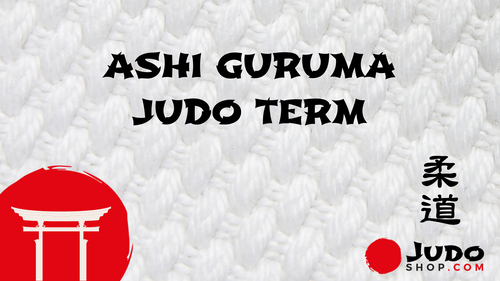Ayumi Ashi - Judo Foot Work Explained
Share

Are you ready to step into the world of Judo and master the art of Ayumi Ashi - 歩み足?
This fundamental footwork technique will take your skills to new heights.
You'll glide effortlessly across the mat with Ayumi Ashi, maintaining your balance and control like a seasoned Judoka.
Whether you're a beginner or a seasoned pro, this article covers you.
Get ready to unlock the secrets of Ayumi Ashi and elevate your Judo game. Let's dive in!
Key Takeaways
- Ayumi-ashi is a type of footwork used in Judo.
- It involves walking forwards or backwards with a sliding motion, crossing the feet like in normal walking.
- The purpose of ayumi-ashi is to maintain the practitioner's center of gravity while moving.
- Ayumi-ashi is one of the five ashi-sabaki (footwork techniques) in Judo.
The Origins of Ayumi Ashi in Judo
Do you know the origins of Ayumi Ashi in Judo? Ayumi Ashi, which means "walking foot" in Japanese, is a fundamental footwork technique used in Judo.
Its origins can be traced back to the founder of Judo, Jigoro Kano. Kano developed Ayumi Ashi as a way to maintain balance and control while moving during Judo practice and competition.
The benefits of Ayumi Ashi in Judo are numerous. It helps practitioners maintain their center of gravity, allowing for better balance and control.
This footwork technique also improves kinaesthetic awareness, as it requires practitioners to move without telegraphing their intentions.
Ayumi Ashi is versatile in movement, allowing for smooth transitions in various techniques and situations.
Common training techniques for Ayumi Ashi in Judo include practicing basic footwork drills, such as walking forward and backward with sliding motions.
Advanced applications of Ayumi Ashi include using it to move in and out of range, evading attacks, and setting up techniques.
However, there are common mistakes to avoid when using Ayumi Ashi in Judo. These include crossing the feet too much, losing balance by leaning too far forward or backward, and not maintaining a low and stable center of gravity.
It is important to practice Ayumi Ashi under the guidance of a qualified instructor to ensure proper technique and avoid these mistakes.
The Importance of Ayumi Ashi in Judo Techniques
Maintaining proper Ayumi Ashi footwork is crucial for executing effective Judo techniques.
Ayumi Ashi, a type of footwork used in Judo, offers several benefits to practitioners. It helps maintain the practitioner's center of gravity, improves kinaesthetic awareness, and allows for versatility in movement.
To practice Ayumi Ashi in Judo, start in a basic stance with your feet shoulder-width apart and knees slightly bent.
Move forward by sliding your front foot while maintaining contact with the ground, and have your back foot follow.
To move backward, slide your back foot backward while maintaining contact, and have your front foot follow.
Common challenges in mastering Ayumi Ashi include maintaining balance and control and coordinating the sliding motion.
To improve Ayumi Ashi for competitive Judo, it is essential to practice regularly and focus on developing balance and stability.
Implementing Ayumi Ashi in Judo throws involves using footwork to create openings and opportunities for executing techniques.
By practicing Ayumi Ashi and incorporating it into Judo training, practitioners can enhance their overall performance and effectiveness in the sport.
Training Ayumi Ashi in Judo: Tips and Techniques
You can improve your Ayumi Ashi footwork in Judo by practicing regularly and focusing on developing balance and stability. Here are some tips and techniques to help you train your Ayumi Ashi in Judo:
- Common drills for improving Ayumi ashi in Judo:
- Ayumi Ashi walking drill: Practice walking forward and backward with Ayumi Ashi footwork, focusing on maintaining balance and proper body positioning.
- Lateral movement drill: Move sideways with Ayumi Ashi footwork, crossing one foot in front of the other, to improve balance and agility.
-
Shadow Judo drill: Perform shadow Judo techniques, incorporating Ayumi Ashi footwork, to simulate real-life situations and improve muscle memory.
-
Footwork variations in Ayumi ashi for Judo practitioners:
- Diagonal Ayumi Ashi: Practice moving diagonally with Ayumi Ashi footwork to enhance your ability to change directions quickly and efficiently.
-
Circular Ayumi Ashi: Incorporate circular movements with Ayumi Ashi footwork to improve your footwork versatility and adaptability.
-
How to incorporate Ayumi ashi into Judo throws and takedowns:
- Use Ayumi Ashi to set up throws: Utilize Ayumi Ashi footwork to create openings and opportunities for executing throws by moving in and out of range.
- Maintain balance with Ayumi Ashi during takedowns: When attempting takedowns, focus on using Ayumi Ashi footwork to maintain your balance and stability throughout the technique.
Advanced Applications of Ayumi Ashi in Judo
Explore the advanced applications of Ayumi Ashi in Judo and discover how it can enhance your technique and strategy in the sport.
Ayumi Ashi, also known as sliding footwork, is a fundamental footwork technique in Judo that involves walking forward or backward with a sliding motion. It is essential for maintaining balance, control, and stability during movement.
In advanced Judo, Ayumi Ashi can be used in various ways to gain an advantage over your opponent.
| Advanced Variations | Timing and Coordination | Countering Techniques | Ayumi Ashi in Competition |
|---|---|---|---|
| - Switching between forward and backward Ayumi Ashi to confuse your opponent and create openings for attacks. | - Timing your Ayumi Ashi to coincide with your opponent's movements, allowing you to effectively evade their attacks and counter with your own. | - Using Ayumi Ashi to counter your opponent's throws and takedowns by quickly adjusting your positioning and disrupting their balance. | - Incorporating Ayumi Ashi into your competition strategy to maintain constant movement and pressure, making it difficult for your opponent to anticipate your actions. |
| Ayumi Ashi in Self Defense |
|---|
| - Applying Ayumi Ashi in self-defense situations to create distance between yourself and your attacker, allowing you to escape or create opportunities for counterattacks. |
| - Using Ayumi Ashi to quickly move out of the way of strikes and maintain your balance, enabling you to effectively defend yourself. |
| - Incorporating Ayumi Ashi into your self-defense training to develop better body control and awareness in high-pressure situations. |
Mastering Ayumi Ashi: Common Mistakes to Avoid in Judo
Don't overlook the importance of proper foot placement when mastering Ayumi Ashi in Judo. It may seem like a small detail, but it can greatly affect your technique and performance. Here are some common errors to avoid when practicing Ayumi Ashi:
-
Crossing your feet too closely together can throw off your balance and make it difficult to move smoothly. Make sure to maintain a comfortable distance between your feet as you slide them forward or backward.
-
Lifting your feet too high off the ground: Ayumi Ashi is meant to be a sliding motion, not a lifting or stomping motion. Keep your feet close to the ground to maintain control and stability.
-
Neglecting your upper body posture: Your footwork is closely connected to your overall body posture. Keep your upper body upright and relaxed, with your shoulders back and your core engaged. This will help you maintain balance and generate power in your techniques.
In addition to avoiding these common errors, there are several benefits to mastering Ayumi Ashi in Judo:
-
Improved footwork and movement: Ayumi Ashi allows for smooth and efficient movement on the mat, enabling you to quickly position yourself for throws, sweeps, and other techniques.
-
Enhanced balance and stability: Proper foot placement in Ayumi Ashi helps you maintain your center of gravity, making it harder for your opponent to destabilize you.
-
Competitive advantage: Ayumi Ashi is a fundamental footwork technique in Judo, and mastering it can give you an edge in competition by enabling you to execute techniques with precision and speed.
To improve your Ayumi Ashi in Judo, here are some drills you can incorporate into your training:
-
Sliding footwork drills: Practice sliding your feet forward and backward, focusing on maintaining proper foot placement and balance.
-
Partner drills: Work with a partner to practice Ayumi Ashi footwork while engaging in grip fighting and throwing techniques. This will help you develop the ability to execute Ayumi Ashi in a dynamic and realistic context.
-
Shadow drills: Visualize an opponent in front of you and practice Ayumi Ashi footwork, imagining yourself moving in response to their attacks and initiating your own techniques.
Frequently Asked Questions
What Are Some Common Variations of Ayumi Ashi Footwork in Judo?
In Judo, some common variations of ayumi ashi footwork include timing and rhythm, agility and balance, transitioning between techniques, and combining ayumi ashi with other footwork patterns. Practice these for improved performance.
How Does Ayumi Ashi's Footwork Contribute to the Overall Strategy and Tactics in Judo?
Ayumi ashi footwork is crucial for strategy and tactics in Judo. It allows you to maintain balance control and create openings for offensive techniques. Drills can enhance your footwork while countering your opponent's ayumi ashi can disrupt their attacks.
Are There Any Specific Drills or Exercises That Can Help Improve Ayumi Ashi's Footwork in Judo?
To improve your Ayumi Ashi footwork in Judo, try drills like the Basic Ayumi Ashi Footwork Drill. Focus on balance and control during movement to enhance agility and speed. Practice transitioning smoothly between different variations for optimal execution.
Can Ayumi Ashi Footwork Be Used Effectively in Both Offensive and Defensive Situations in Judo?
Ayumi ashi footwork can be effectively used in both offensive and defensive situations in Judo. Its sliding motion and versatility allow for quick movements, setting up techniques, and maintaining balance during attacks and counters. Regular practice and drills can improve ayumi ashi's footwork.
Are Any Specific Strategies or Techniques Can Be Used to Counter an Opponent's Ayumi Ashi Footwork in Judo?
To counter an opponent's ayumi ashi footwork in Judo, you can employ techniques like foot sweeps, hip throws, or grip-breaking strategies. Disrupting their balance and timing can effectively neutralize their ayumi ashi.
Conclusion
In conclusion, mastering Ayumi Ashi in Judo is like finding your rhythm on the dance floor. Just as a graceful dancer moves with fluidity and precision, a Judoka who has honed their footwork technique can effortlessly glide across the mat.
Ayumi Ashi not only enhances balance and control, but it unlocks a world of possibilities in executing throws, strikes, and evasive maneuvers. So, step into the world of Ayumi Ashi and unleash the power within your feet.
Related Posts
-

Kayla Harrison's Judo Journey - Judo Champion Turned MMA Powerhouse
Kayla Harrison is a groundbreaking American judoka who made history by becoming the first American woman to win an Ol...
-

Judo Atlanta - List of Judo Clubs in Atlanta area
In Atlanta, you can find excellent judo clubs such as Atlanta Judo Midtown and Black Ice Fitness where you can train...
-

Guram Tushishvili Disqualified - JUDO DRAMA with Teddy Riner
Guram Tushishvili Disqualified - Unsportsmanlike Behavior to French Judoka Teddy Riner Leads to Disqualification fro...
-

Yeldos Smetov - Judoka Profile
Yeldos Smetov, a name synonymous with excellence in judo, has carved out an illustrious career that stands as a beac...
-

Judo Olympics 2024 Results - Gold, Silver, and Bronze Medalists
The Judo Olympics 2024 Results are eagerly anticipated as the Paris Games approach, promising a thrilling display...
-

Judo For Self Defense - Here Is Why Is Judo Best For Self-Defense
Judo For Self Defense packs a punch. This martial art, born in Japan, turns attackers' strength against them. No nee...
-

Ashi Hara Gatame - Judo Term Explained
Ashi Hara Gatame is a specialized technique in the martial art of judo, combining leg control, abdominal pressure, a...
-

Ashi Gatame - Judo Term Explained
Ashi Gatame is a Judo technique referring to a kansetsu-waza (joint lock) where one uses their legs to immobilise ...
-

Judo Olympics 2024: Highlights, Athletes, and Schedules
Judo Olympics 2024 enthusiasts, mark your calendars! From July 27 to August 3, the Grand Palais Éphémère near the Eif...
-

Ashi Garami - Judo Term Explained
What does "Ashi garami" mean in Judo? "Ashi garami" (足緘) is a Japanese term used in Judo that literally translates t...
-

Ashi - Judo Term Explained
Ashi is term in Judo, referring to a leg or foot and category of judo techniques designed to unbalance and throw an ...
-

Anza - Judo Term Explained
The term Anza in Judo (安座) embodies a significant practice beyond merely sitting; it signals a deep respect and disc...
-

Ashi Guruma - Judo Term Explained
Ashi Guruma is a Judo term rooted in the martial art of Judo, which translates from Japanese as 'leg wheel'. This ju...
-

Judo vs BJJ? Of course Judo! Judo is better!
Welcome to Judoshop.com, the premier destination for judo enthusiasts worldwide. Here, we cater to beginners and vet...
-

Hantei Judo Term Explanation
Contrary to popular belief, the term 'Hantei' in Judo is not just a simple decision-making process. It holds the p...
-

Dojo Meaning (updated 2023)
Dojos, places of immersive learning and meditation, hold great significance in martial arts. Derived from the Japane...
-

Hajime - Judo Term Explained
Ready to learn about Hajime in judo?It's all about using throws, pins, and joint locks on the mat. With the command ...
-

Bushido Explained
Bushido, the traditional code of ethics followed by samurai warriors in feudal Japan, is a subject that fascinates ...
-

Ippon - Judo Term Explained
Imagine stepping onto the mat and feeling the adrenaline rush through your veins. In the world of judo, one ultimate...
-

Budo - Term Explained
In a world full of chaos and conflict, one finds solace in the ancient art of budo. Contrary to popular belief, budo...
-

Arigatou - Judo Term Explained
Do you ever wonder about the true meaning behind the Japanese word 'Arigatou'? Well, wonder no more! 'Arigatou' is a...
-

Aka Obi - Judo Term Explained
The aka obi, a red belt worn in Judo, is a prestigious symbol of expertise. Typically reserved for those holding a 9...
-

Why Are There 2 Bronze Medals In Judo
Judo is a unique sport that gives two bronze medals in each weight class. Many people wonder why this is done. To fi...
-

Ai Yotsu - Judo Term Explained
In the world of Judo, a term holds immense significance - Ai Yotsu. This grip, characterized by an intense and intim...
-

Is Judo Dangerous - Unveiling the Shocking Truths Behind this Ancient Martial Art
With its powerful throws and complex grappling techniques, one might wonder, "Is judo dangerous?" Yes, judo can po...
-

Is Judo The Toughest Sport - Unraveling the Grit and Grace of the Gentle Way
Judo, known as the Gentle Way, may seem like a paradoxical name for a sport, but don't let that fool you. While Ju...
-

Judo Terms - Complete List Of Judo Terms
Judo terms are the foundation of this martial art...
-

English to Japanese Kanji and Hiragana translations
Are you looking for an English to Japanese Kanji translation? Here you can find more than 30 examples of Kanji and ...




























